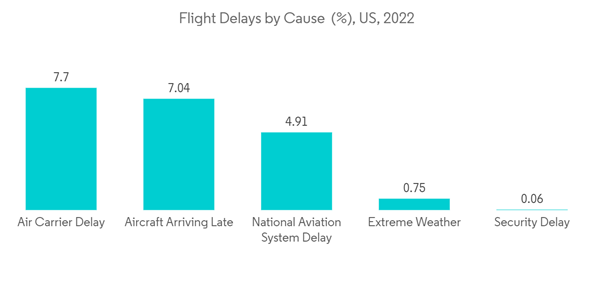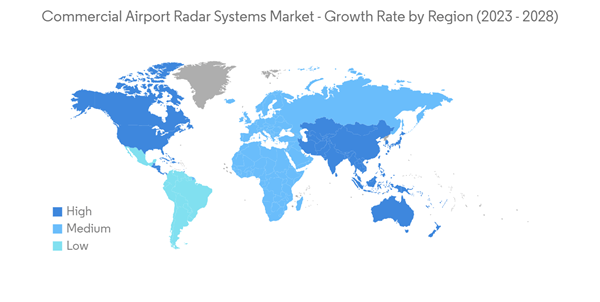The COVID-19 pandemic had a significant impact on the commercial airport radar systems market, leading to reduced air travel demand, delays in airport infrastructure projects, and constrained budgets for radar system upgrades. As a result, the market experienced a downturn with slower growth and a focus on cost-effective solutions during the pandemic.
Runway incursions pose a great threat to aircraft and human safety. Hence, global aviation is constantly focused on reducing the number of incursions that take place annually. Innovations in surface movement radar that keep track of vehicular traffic, human movement, etc., are supporting the growth of the commercial airport radar systems market. Airport surveillance radar is increasingly in demand and is being placed in airports to reduce aviation accidents. Air travel will become more efficient and safer as technology in the field of surveillance radar advances.
The rapid development of aviation infrastructure in developing economies, such as India and China, due to the increased air traffic resulting from a rising standard of living and low airfares, is propelling the airport and runway development and, subsequently, the market for commercial airport radar systems. The surveillance radar segment is witnessing several innovations, such as 3D technology incorporation, augmented reality for better situational awareness, etc.
Commercial Airport Radar Systems Market Trends
Weather Radars Segment is Expected to Witness Significant Growth During the Forecast Period
The use of weather radars in airports is of much importance due to the requirement for monitoring weather conditions, as they might hamper airlines' operations. If the weather conditions are not monitored, landing and take-off operations may be affected, which may risk the lives of passengers. Due to the rise in pollution levels in major cities across the world, flight diversions and cancellations became common incidents due to low visibility arising due to smog. Storms and low clouds are the other prominent factors that affect the safety of aircraft and passengers.For example, in July 2023, NATS, the primary air traffic control provider in the United Kingdom, commenced development on a new virtual contingency facility (VCF) at Heathrow Airport, which will act as a backup to the control tower. Heathrow's existing world-first VCF will be replaced with the new VCF. Earlier in 2023, NATS completed another important modernization project for the UK's airspace with the West Airspace Deployment. It inaugurated systemization and free route airspace across Wales and Southwest England to make air traffic more sustainable in the region. Likewise, in June 2022, NATS, the UK air traffic services provider, awarded Terma the contract to offer wind turbine interference mitigation for Inverness Airport. It was recently crowned the finest airport in Europe, with fewer than 2 million passengers per year by Airport Council International (ACI). With the latest order for a SCANTER 4002 radar, Terma radars will be in use at four of Scotland's five main airports.
Asia-Pacific is Anticipated to Exhibit the Highest Growth Rate During the Forecast Period
The rapid development of aviation infrastructure in economies such as India and China is propelling the growth of the commercial airport radar systems market in the region. The development of new airports in the region is fuelling the demand for the latest commercial airport radar systems. The air traffic in the region is increasing, owing to the rise in the standard of living and the decreasing cost of air travel. China's aviation industry is expected to become the largest in the world by 2030. By 2035, the Civil Aviation Administration of China aims to construct over 200 new airports to reach its target of 450 airports. India is also witnessing a constant increase in air traffic and aircraft movements.For instance, in 2021, South Korea's domestic air traffic exceeded pre-pandemic levels in the second quarter of 2021 as more people chose to travel within the nation despite continuing limitations on foreign travel. As domestic air travel in Korea recovers, the most advanced airport surveillance technology will ensure that travelers continue to enjoy seamless and safe flights around the country. As Korea Airports Corporation (KAC) seeks to modernize Air Traffic Management infrastructure throughout Korean airports, Thales was awarded a contract to deliver three next-generation airport surveillance radar systems in the southern cities of Muan, Ulsan, and Yeosu, in collaboration with Hanjin Information Systems and Telecommunications (HIST). The radar systems are comprised of Thales' cutting-edge STAR NG primary surveillance radars co-mounted with the latest version of RSM NG secondary surveillance radars. These provide the highest levels of detection performance, reliability, and cybersecurity to help airports meet their surveillance needs and protect passenger safety.
Commercial Airport Radar Systems Industry Overview
The commercial airport radar systems market is moderately consolidated. It is marked by the presence of several global players that generate revenues through their capabilities and innovations that help them secure orders from the growing aviation infrastructure development market. The prominent market players include RTX Corporation, NEC Corporation, Indra Sistemas, S.A., Terma A/S, and THALES. The market players are focused on increased collaborations to produce state-of-the-art technologies for customers at reasonable rates. The market is driven by high investments in innovation by major players. Also, international exporters need to get clearance from various official security and purchasing authorities of the buyer country in order to sell their products and systems.For instance, in November 2022, Indra Sistemas, S.A., a Spanish technology and consultancy firm, won a contract from German air navigation service provider DFS to modernize the country's network of air surveillance radars. The contract, worth more than USD 109 million, would be implemented within 13 years and includes an extended possibility based on the release of the various possibilities envisioned.
Likewise, in June 2022, Saab AB and Robin Radar Systems signed an agreement to collaborate on worldwide business potential. The purchase agreement gives Saab AB access to Robin Radar's whole portfolio of drone and bird detection radar systems for a variety of worldwide clients in the aviation and security sectors.
Additional Benefits:
- The market estimate (ME) sheet in Excel format
- 3 months of analyst support
This product will be delivered within 2 business days.










